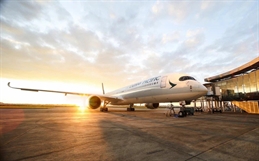
The Cathay Pacific Group has released combined traffic figures for April that reflected the airlines’ substantial capacity reductions in response to significantly reduced demand as well as travel restrictions and quarantine requirements in place in Hong Kong and other markets amid the ongoing global COVID-19 pandemic.
The Hong Kong flag carrier said Cathay Pacific and Cathay Dragon carried 84,634 tonnes of cargo and mail last month, a decrease of 48.3% compared to April 2019.
The month’s revenue freight tonne-kilometres (RFTKs) also fell 37.3% year-on-year as the capacity, measured in available freight tonne kilometres (AFTKs), was down by 44.1%.
In the first four months of 2020, both airlines saw the tonnage fell by 26.6% against a 25.4% drop in capacity and 20.6%, as compared to the same period for 2019.|
Very bleak outlook
The airlines carried a total of 13,729 passengers last month, a decrease of 99.6% year-on-year and in the first four months of 2020, the number of passengers carried dropped by 64.4% against a 49.9% decrease in capacity.
“The COVID-19 pandemic continues to impact us in an unprecedented way. Year-to-date up to April, we made an unaudited loss of HK$4.5 billion at the full-service airline level (Cathay Pacific and Cathay Dragon) and the financial outlook continues to be very bleak for the coming few months at least," said Ronald Lam, Cathay Pacific Group chief
customer and commercial officer.
Cargo impacted by belly cargo contraction
“Overall tonnage uplift in April dropped by almost a third compared to the previous month, it is particularly impacted by the further contraction of our belly capacity across our passenger network," Lam said.
The movement of certain cargo, such as perishables, seafood, live animals, industrial parts and equipment, was also negatively affected by lockdown measures around the world, he added, noting however that the Cathay Pacific Group continued to carry significant quantities of medical supplies from mainland China and Hong Kong.
Highest demand routes prioritized
Cathay Pacific noted that significant effort was made to prioritise capacity for routings with the highest airfreight demand, most notably to the Americas, Australia and Europe.
The airline said it also increased the utilisation of its existing freighter fleet, chartered more flights from our subsidiary Air Hong Kong, and successfully operated over 500 pairs of cargo-only passenger flights – more than double the number it operated in March.
"To further expand our available capacity, at the end of April we began loading cargo in the cabins of our Boeing 777 passenger aircraft, which we expect will serve long-haul markets especially well in the months to come," it added.
Much more prolonged recovery
Citing the International Air Transport Association (IATA) analysis indicating airlines in Asia Pacific will see the largest revenue drop of US$113 billion and a 50% fall in passenger demand year-on-year, Cathay Pacific said recovery could take some time.
“Industry bodies and analysts are now predicting a much more prolonged recovery for the global aviation industry, with international travel expected to pick up more slowly than domestic travel as border restrictions are only gradually eased," Lam said.
He added that with this it is "widely expected" that international travel demand will only return to pre-COVID-19 levels in a few years.
Lam noted that as Hong Kong’s home carriers, the Group does not have the benefit of a domestic passenger network as a buffer — and the airlines will continue to operate a minimal schedule over the next two months with the intention to slightly increase passenger flight capacity from 3% in May to 5% in June.
“At this stage, we still see no immediate signs of improvement ... overall, we do not anticipate we will see a meaningful recovery for an extended period," Lam said.
“This is the biggest challenge to aviation we have ever witnessed. We are evaluating all aspects of our business to ensure that we remain strong and competitive when we emerge from this crisis," he added.



